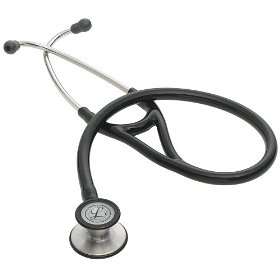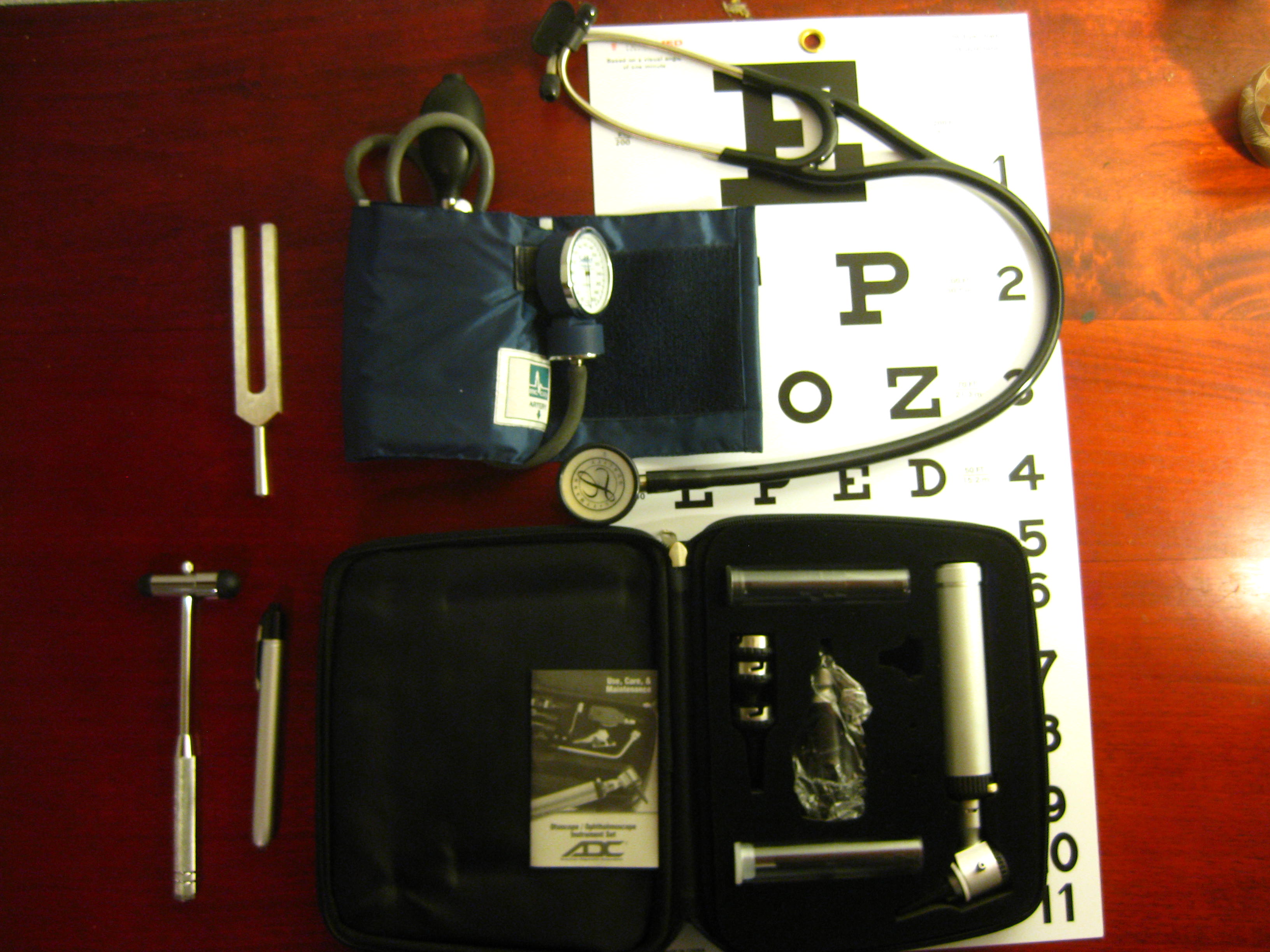ICM Physical Examination Equipment

The Physical Examination is one of the most important components of evaluating patients, and learning the proper skills is not something you can get from self-learning in books. You’ll need training from experienced physicians (our ICM professors), regular practice on each other, and last, but not least, the proper equipment needed to conduct the physical exams. I’ve compiled a list of the equipment we need for Introduction to Clinical Medicine (ICM), which we take from first (as of January 2014) through fifth semester at AUC. This list is directly from the school’s required equipment list.
Although you’ll get a list of all the equipment in your orientation packet, in reality, you won’t need all of these until your second semester. For your first semester, you’ll only really be using the stethoscope and the sphygmomanometer (aka blood pressure cuff). If you are strapped for cash, especially before your first student loan check comes in, I’d recommend buying these two equipment first, and then buying the rest of the equipment later on after you get your loan check before second semester.
While the equipment is expensive, it’s important to remember that the equipment you buy is an investment for your career. Not only will you be using them in class, but you’ll also use them during your clinical rotations, residency, and future practice as a physician. Having your own set of equipment is also important in that you can refine your skills and experience using them by practicing on your classmates, friends, and family members anytime, anywhere.
- Otoscope/Ophthalmoscope Set (Diagnostic Set) Welch Allyn 97250-MC or 97250-MS
The school strongly recommends buying the Welch Allyn equipment stated above because they have a coaxial ophthalmoscope head, which makes seeing the fundus of the eye MUCH easier than with a standard head, or that of cheaper brands. In my experience, this is true. Before I started taking ICM, I cheaped out and bought an ADC ophthalmoscope/otoscope set for half the price of a Welch Allyn, and it turned out to be very frustrating to use. There’s always this reflection in it when you try to look through it, forcing you to spend a lot of time wriggling around a lot trying to get one perfect angle to see the fundus or macula (and your patient won’t be happy with you shining a bright light in their eye for that long!). In contrast, when I tried using my friends’ Welch Allyn, I could spot the fundus and macula clearly and very quickly with ease. It took me nearly three semesters to finally get used to seeing anything out of my cheap ADC Ophthalmoscope, whereas many of my classmates that invested in the Welch Allyn have already moved way beyond simply being able to “see” the fundus and actually do diagnostic analysis of what they see. For this reason, I would highly recommend investing in a nicer, albeit more expensive, Welsh Allyn ophthalmoscope/otoscope to fully take advantage of learning how to do eye exams without wasting time just trying to see anything at all through it.Not to mention, you’ll need to be able to see the inside of the eye in order to pass the big comprehensive Physical Examination Competency Test during ICM 5. It’s not good to “pretend” that you see it just to get the points. More importantly, you’ll be evaluating real patients during your clinical years, and you’ll really need to see your patients’ eyes clearly and quickly to get an accurate assessment. Not every hospital will already have ophthalmoscopes on the walls in the patient rooms.
- Stethoscope Littman Cardiology III
or Littman Master Cardiology
This is an important investment and a tool you’ll be using for the rest of your career. Because of this, it’s important to get the best. My fiancee’s family got me the Littman Cardio III (which is what the school recommends) and I absolutely love it. It has both a diaphragm and a bell, which you can switch between the two by twisting, and the sound quality is very good. Besides using it for ICM, you’ll also be expected to bring your own Stethoscope during your mini-rotations during ICM 5 (which I actually didn’t do and got confronted by the Attending in the ER… not good). You’ll also need it for your clinical rotations during your third and fourth years of med school and of course, the rest of your career.
- Portable Sphygmomanometer
You’ll need a portable, one-piece sphygmomanometer/pressure cuff to take blood pressure. Any brand should be OK, but make sure the cuff fits the “average” adult arm (rather than pediatric cuff or extra large cuff). I got the McCoy, and it works fine for me.
- Mini Snellen Eye Chart
To test for visual acuity, you’ll also need a MINI Snellen Eye Chart, which means it’s made for the patient to read it 6 feet or 14 inches away, rather than the usual 20 ft. You’ll need a mini because most patient rooms you’ll encounter in the future (as well as in ICM) are small and do not have 20 feet of space for you to use to perform the visual acuity exam.
- Tuning Fork 128 cps
You’ll need this to do the Rinne and Webber tests for the ear as well as vibratory senses for the cerebellar tests. Any brand should be ok.
- Penlight
You’ll need this to do accomodation tests for the eye as well as to examine the mouth. Any brand should be ok… afterall, it’s just a mini-flashlight right?
- Flexible Measuring Tape
I’m not sure why this is in the school’s required equipment list for ICM. We’ve never had to use a measuring tape at all for ICM. The closest thing we’ve had to use was a ruler and an index card to measure JVP from the sternal angle. So for now, I would suggest just get a small ruler with centimeters. If you sign up for pediatrics for your mini-rotations for ICM 5, however, you may need a flexible measuring tape to measure the head circumference of kids. And if you sign up for OB/GYN, you may need to measure the fundal height of pregnant women. And of course, during your pediatric and OB/GYN rotations during third and fourth years, that may come handy too.
- Reflex Hammer
You’ll need this to test for reflexes. The most common, simple, cheapest, and lightweight hammer is the Taylor Percussion Hammer, and it also has a pointy handle so you could do Babinski test as well with it. I personally got the Buck hammer, and it works fine for me. Some people also like the Tromner Hammer since it’s supposedly easier to get a reflex out of someone with it, and it has a softer tip, which makes it less painful when you bang on your own thumb while performing the biceps tendon reflex on your patient.
You’ll learn how to do different physical examinations every semester, and it builds up. By the end of fourth semester, you would have already learned how to do everything you need to do. To test these skills, during fifth semester, you’ll be taking a comprehensive Physical Examination Competency Test for ICM 5, in which you will have to perform all the skills you have learned over the semesters on a patient (usually another student who volunteers), by memory, one-on-one in front of your evaluator.
You’ll be graded on 251 different things you have to do off of a checklist, and you need to perform at least 85% of them correctly in order to pass the class. 251 things seems like a lot to do from memory but with practice, these skills become second nature. Also, you are required to complete the entire physical exam (all 251 points) in 1 hour, which can be difficult to do if you don’t know what you are doing. Because of this, I highly recommend you find a partner to practice with and meet up several times a semester to go over the skills you’ve learned. Some examination skills like deep tendon reflexes or using the ophthalmoscope especially takes more practice than any other skill in my experience, and therefore it’s good to dedicate more time to these as well. Every time you meet up to practice, try to not only learn how to do the skills correctly, but also learn the order in which you do them so you won’t have to struggle trying to remember what you have to do next by the time you get to the Physical Exam Competency Test during fifth semester.
To see a simplified list of the physical exams we learn to do during ICM, click here.














You’ll use the measuring tape at some point to measure the size of an expectant mother’s uterus; during the third trimester, fundal height should be within 2 centimeters of the length of gestation.
Thanks for the clarification Katie! 🙂
Do they require you to have a bell on your stethoscope? I have a Littman Master Classic that only has a diaphragm, but the diaphragm is tunable for high/low frequencies depending on the pressure you put on the chestpiece.
Hi Brent, as long as your stethoscope can be tunable for low or high frequency, like you described, it should be fine.
Hi Benji,
Could you recommend which set to get? Is a stethoscope not needed? I am very confused and have no idea which to buy or if I should shop for these separately at a different vendor for lower prices.
Thanks for your help!
http://andar-international.myshopify.com/collections/auc
Hey Jeff, you’ll definitely need a stethoscope and blood pressure cuff (sphygmomanometer) for first semester. The rest you can get starting second semester – most importantly otoscope/ophthalmoscope, tuning fork, and reflex hammer. I bought mine separately. You can probably find some cheaper ones on Amazon or eBay if you shop around.
Benji
Also, is the lithium ion handle necessary? Does it offer a great benefit?
I dont think it matters. I got one that used regular batteries. The Li ion one is rechargeable. What matters more is to get an ophthalmoscope head that is Coaxial, as you can see the fundus of the eye much more easily without there being a reflection.
Hey mehn,
Would you recommend a student to purchase all the ICM equipments before coming to the island or stagger the purchases; i.e. purchase only what you’ll need in before each sesmester.?
Hi Benji,
did you get your stethoscope with 22″ or 27″ tubing? The school recommends 22″ but most places only seem to have the 27″ since that’s the standard sizing. Do you have any opinions about this?
Hi Pallavi, I don’t think there’s much of a difference. Shorter supposedly has better sound but for longer lengths, you dont have to bend over as much listening to a patient. I’d say it’s personal preference.
Benji